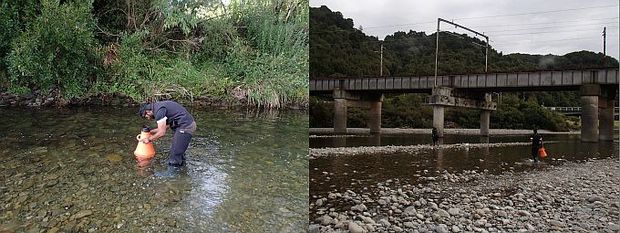
Shyam Morar (left) uses an underwater viewer to determine amounts of toxic cyanobacteria and algae cover in the Hutt River at the Silverstream sampling site (right). (Images: A. Ballance)
Each week during summer, from November to March, councils around the country test water quality at popular river and coastal bathing sites to ensure they are safe for swimming. Toxic algae and faecal contamination are two important factors that are considered.
Alison Ballance joins Summer Greenfield, a Senior Environmental Scientist in Water Quality and Freshwater Ecology at the Greater Wellington Regional Council, and Shyam Morar, a water quality technician with Greater Wellington, on the Hutt River, to find out how the weekly sampling is carried out. Water clarity, and percentage cover of toxic cyanobacteria and algae, as well as sediment, are then calculated for each site, which are then given a Suitability for Recreation grade.
The testing includes collection of a water sample that is taken to the lab for microbiological testing, and Alison follows the sample to Eurofins ELS where Tiana MacEwan receives and processes the sample, and Sunita Raju, Microbiology Team Leader, shows her how the sample is prepared. E coli is the indicator species used in freshwater samples to indicate faecal contamination, which may come from human sources as well as livestock and birds. After a 24-hour incubation the number of colony-forming units on each agar plate are compared to national standards (which define a simple traffic-light system of green, amber and red); if samples exceed certain levels councils place warnings online and on signs at the affected site.
National recreational water quality standards are set by the Ministry for the Environment.
You can listen to an earlier Our Changing World interview about a trial using a UAV to monitor toxic algae blooms from the air here.


